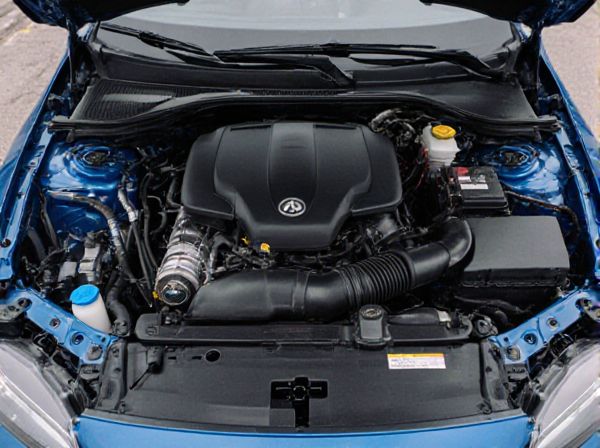
Photo illustration: Square vs Undersquare
Square and undersquare engines differ primarily in their bore-to-stroke ratio, significantly influencing performance characteristics. Square engines have equal bore and stroke dimensions, providing a balance between power and torque ideal for versatile driving conditions. Your choice between these depends on whether you prioritize high-revving horsepower (square) or low-end torque and fuel efficiency (undersquare).
Table of Comparison
| Engine Type | Bore x Stroke | Characteristics | Performance | Common Applications |
|---|---|---|---|---|
| Square Engine | Bore = Stroke | Balanced design; optimal combustion efficiency; reduced vibration | Moderate power; balanced torque and RPM range | Everyday passenger cars; balanced performance vehicles |
| Undersquare Engine | Bore < Stroke | Long stroke; higher piston speed; improved low-end torque | Higher torque at low RPM; lower peak power and RPM limit | Diesel engines; trucks; heavy-duty vehicles |
Introduction to Square and Undersquare Engines
Square engines have equal bore and stroke dimensions, optimizing a balance between power output and engine speed, commonly used in versatile automotive applications. Undersquare engines feature a smaller bore than stroke length, emphasizing torque and fuel efficiency at lower RPMs, making them ideal for heavy-duty and fuel-conscious vehicles. Understanding these configurations aids in selecting engines tailored to specific performance and efficiency requirements.
Defining Square and Undersquare Engine Concepts
Square engines feature a bore and stroke of equal length, optimizing a balance between power and torque delivery. Undersquare engines have a smaller bore compared to the stroke, enhancing torque at lower RPMs but limiting high-rev performance. Understanding these concepts is crucial for selecting the appropriate engine configuration based on desired vehicle dynamics and performance characteristics.
Key Differences Between Square and Undersquare Designs
Square engines feature a bore and stroke of equal length, optimizing a balance between torque and high-rev power, which enhances overall engine efficiency. Undersquare engines have a smaller bore and longer stroke, resulting in higher torque at lower RPMs but limiting maximum engine speed due to increased piston speed. These design variations impact combustion characteristics, thermal management, and engine durability, influencing vehicle performance and fuel economy.
Advantages of Square Engines
Square engines, characterized by equal bore and stroke dimensions, offer a balanced combination of power and efficiency, promoting better high-rev performance compared to undersquare engines. Their design allows for optimized combustion chamber shape, which enhances fuel efficiency and reduces emissions. Moreover, square engines generally provide smoother operation and longevity due to reduced piston speed stress.
Benefits of Undersquare Engines
Undersquare engines, characterized by a smaller bore and longer stroke, offer increased torque at lower RPMs, making them ideal for applications requiring strong low-end power delivery. Their design often leads to improved fuel efficiency and better thermal efficiency due to reduced surface area relative to combustion volume. This configuration enhances engine durability and smoothness, especially in heavy-duty and off-road vehicles where consistent power output is crucial.
Performance Implications: Power and Torque
Square engines, featuring equal bore and stroke dimensions, optimize combustion efficiency and balance, delivering moderate power and torque suitable for balanced performance needs. Undersquare engines, characterized by a smaller bore and longer stroke, generate higher torque at lower RPMs due to increased leverage on the crankshaft, enhancing acceleration and load-carrying capabilities. The trade-off involves square engines typically supporting higher RPM ranges for peak power output, while undersquare configurations favor torque production and fuel efficiency under strain.
Fuel Efficiency Considerations
Square engines, with bore and stroke approximately equal, generally offer a balanced combustion process resulting in moderate fuel efficiency and good power output. Undersquare engines, characterized by a smaller bore and longer stroke, typically provide better fuel efficiency due to improved torque at lower RPMs and more complete combustion. The longer stroke in undersquare designs enhances fuel economy by promoting higher thermal efficiency and reduced pumping losses in typical driving conditions.
Application in Modern Automotive Engineering
Square engines, featuring equal bore and stroke dimensions, offer a balanced compromise between power output and engine efficiency, making them ideal for modern passenger vehicles where fuel economy and smooth performance matter. Undersquare engines, with a smaller bore and longer stroke, generate higher torque at low RPM, optimizing their application in heavy-duty vehicles and electric hybrid systems that demand strong pulling power and fuel efficiency. Advances in variable valve timing and turbocharging have enhanced these engine designs, allowing automotive engineers to tailor performance characteristics precisely to the requirements of contemporary transportation needs.
Common Examples and Industry Usage
Square engines, with bore and stroke dimensions nearly equal, are common in motorcycles like the Honda CB500 series, balancing power and efficiency. Undersquare engines, featuring a larger stroke than bore, are frequently used in diesel trucks such as the Ford Power Stroke and heavy machinery due to their higher torque output at low RPMs. The automotive industry favors square engines for versatile performance while undersquare configurations dominate applications requiring durability and strong low-end torque.
Choosing the Right Engine Design
Choosing the right engine design between square and undersquare configurations depends on performance goals and application needs. Square engines, with equal bore and stroke dimensions, provide a balanced mix of torque and high-revving capability, making them versatile for both everyday driving and sport applications. Undersquare engines feature a smaller bore and longer stroke, delivering greater low-end torque and fuel efficiency, ideal for heavy-duty or economy-focused vehicles.
 caratoz.com
caratoz.com